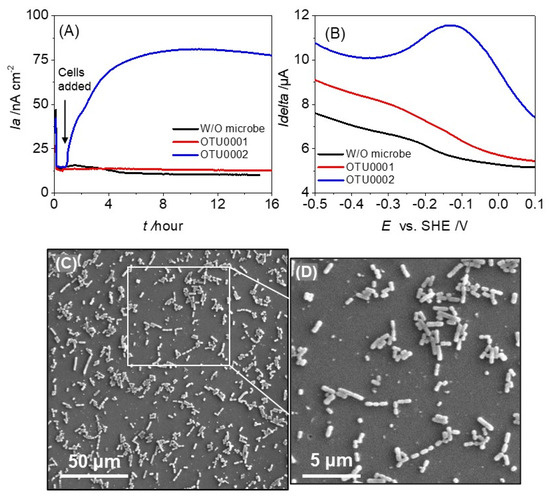New Electrogenic Microbes
A topical collection in Microorganisms (ISSN 2076-2607). This collection belongs to the section "Microbial Biotechnology".
Viewed by 1163Editor
2. School of Chemical Sciences and Engineering, Hokkaido University, 5 Chome Kita 8 Jonishi, Kita Ward, Sapporo, Hokkaido 060-0808, Japan
Interests: bioelectrochemistry; electrochemical biosensor; microbially influenced iron corrosion; biofilm; outermembrane cytochrome
Topical Collection Information
Dear Colleagues,
Since the first reports in 1988, more and more microbes have been suggested or identified to be capable of exchanging electrons with extracellular solids as part of their metabolism, referred to as electrogenic bacteria. While some model-bacteria are extensively investigated as living electrode catalysts to drive various valuable reactions for energy and environmental applications, the importance of electrogenic bacteria for ecophysiology is still poorly understood. Furthermore, some human commensal and pathogenic bacteria have been recently identified as electrochemically active, opening up a new realm of potential importance for these organisms in the human microbiome. However, why or how the lifestyle of pathogens and symbionts uses extracellular electron transport remains unknown. Taken together, we are facing an expanding appreciation for the prevalence of electrogenic bacteria, but understanding their role and significance in many ecosystems remains a challenge. Central to tackling this issue is the cultivation of microbes from their wide-ranging environments, and making a detailed catalog for electrogenic microbes and the habitats where they persist. Ultimately this work can fuel future efforts aimed at understanding the role of microbes in diverse environments.
In this Topic Collection of Microorganisms, we look forward to receiving your article or review concerning any aspects related to electrogenic microbe except model microbes, Shewanella and Geobacter, including basic characterization for electrochemical or electrophysiological properties in pure cultures, isolation of electrogenic microbe from any microbiome, and chemical or physical analysis on nano-scale structure with redox properties. We encourage the submission of works on novel or previously uncharacterized strains, but logic quality and data quantity are strictly required. Studies about novel isolation or enrichment methods for electrogenic microbe are also welcome for this Topic Collection. Review papers that propose the novel role of electrogenic capability will also be considered.
Dr. Akihiro Okamoto
Collection Editor
Manuscript Submission Information
Manuscripts should be submitted online at www.mdpi.com by registering and logging in to this website. Once you are registered, click here to go to the submission form. Manuscripts can be submitted until the deadline. All submissions that pass pre-check are peer-reviewed. Accepted papers will be published continuously in the journal (as soon as accepted) and will be listed together on the collection website. Research articles, review articles as well as short communications are invited. For planned papers, a title and short abstract (about 100 words) can be sent to the Editorial Office for announcement on this website.
Submitted manuscripts should not have been published previously, nor be under consideration for publication elsewhere (except conference proceedings papers). All manuscripts are thoroughly refereed through a single-blind peer-review process. A guide for authors and other relevant information for submission of manuscripts is available on the Instructions for Authors page. Microorganisms is an international peer-reviewed open access monthly journal published by MDPI.
Please visit the Instructions for Authors page before submitting a manuscript. The Article Processing Charge (APC) for publication in this open access journal is 2700 CHF (Swiss Francs). Submitted papers should be well formatted and use good English. Authors may use MDPI's English editing service prior to publication or during author revisions.
Keywords
- extracellular electron transport
- microbial fuel cell
- bioanode
- extracellular electron uptake
- biocathode
- microbial electrosynthesis
- microbially influenced iron corrosion
- pathogen
- archaea
- extremophile
- phototroph
Related Special Issue
- New Electrogenic Microbes in Microorganisms (10 articles)







